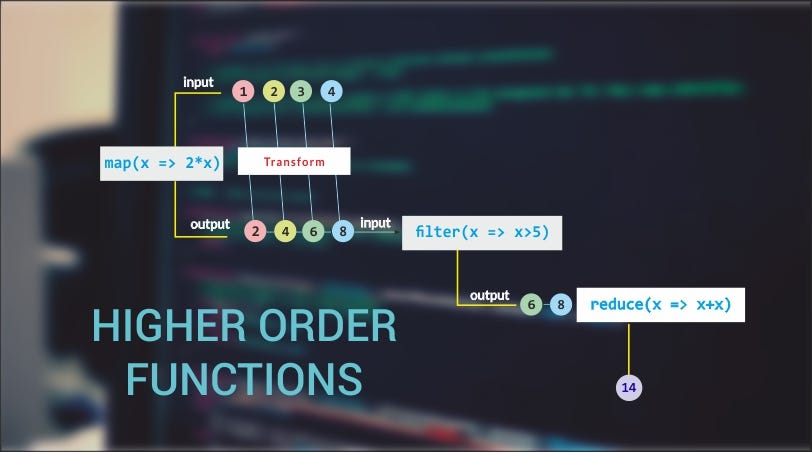In this lesson, we'll learn all about High Order Functions and their usage in javascript.
- Fork and Clone
- Open this repo in your code editor
- Touch an
index.jsfile
- Review "for loops" and the "forEach" method
- Learn common array methods .map(), .filter(), and .reduce()
- Learn how to chain these methods
In JavaScript, functions are first-class citizens, which means, we can pass functions around like values. Higher Order Functions are functions that pass a function as an argument or return a function as a value.
Review: for loops!
const numbers = [1, 2, 3, 4, 5]
for (let i = 0; i < numbers.length; i++) {
console.log(numbers[i])
}
// 1 2 3 4 5- You can call the forEach method on any array and pass it a function to execute on each item in the array.
const numbers = [1, 2, 3, 4, 5]
numbers.forEach((element) => {
console.log(element);
})
// 1 2 3 4 5.map() will take an array, and produce a new array with new values. In a function you define what each value in the array should be based on an existing item.
const words = ['the', 'world', 'is', 'round', 'like', 'an', 'orange']
const wordLengths = words.map((word) => { return word.length })
// wordLengths = [ 3, 5, 2, 5, 4, 2, 6 ]const words = ['the', 'world', 'is', 'round', 'like', 'an', 'orange']
const wordsWrappedInX = words.map((word) => {
const newWord = 'x' + word + 'x'
return newWord
})
// wordsWrappedInX = [ 'xthex', 'xworldx', 'xisx', 'xroundx', 'xlikex', 'xanx', 'xorangex' ].filter() will take an array, and produce a new array that only contains some of the items. Each item in the array runs through a function. If the function returns true, the item is included in the new array.
const words = ['the', 'world', 'is', 'round', 'like', 'an', 'orange']
const shortWords = words.filter((word) => { return word.length <= 3 })
// shortWords = [ 'the', 'is', 'an' ]const words = ['the', 'world', 'is', 'round', 'like', 'an', 'orange']
const wordsThatStartWithR = words.filter((word) => { return word[0] === 'r' })
// wordsThatStartWithR = ['round']- The reduce() method applies a function against an accumulator and each element in the array (from left to right) to reduce it to a single value.
const numbers = [1, 2, 3, 4, 5]
const sum = numbers.reduce((accumulator, value) => {
return accumulator + value
}, 0)
console.log(sum)
// 15NOTE The single value returned can be an object or array. Often in examples it's a number or string but you can return anything. Reduce is extremely powerful and all other iterators can be written using it. It's tough to wrap one's mind around so don't worry if this one is inscrutable for now. We'll revisit it now and again...and again and again.
- The
some()method tests whether at least one element in the array passes the test implemented by the provided function. If at least one element in the array passes the test of the provided functiontrueis returned. If none of the elements pass the testfalseis returned.
const array = [1, 2, 3, 4, 5];
// checks whether an element is even
const greaterThanThree = (element) => element > 3;
console.log(array.some(greaterThanThree));
// expected output: true- When using these array methods we can method chain. So instead of doing:
const numbers = [1, 2, 3, 4, 5];
const mappedNumbers = numbers.map((element) => {
return element + 1;
});
console.log(mappedNumbers)
// [ 2, 3, 4, 5, 6 ]
const filteredNumbers = mappedNumbers.filter((element) => {
return element % 2 === 0;
});
console.log(filteredNumbers)
// [ 2, 4, 6 ]We can do:
const numbers = [1, 2, 3, 4, 5];
const filteredAndMappedNumbers = numbers.map((element) => {
return element + 1;
}).filter((element) => {
return element % 2 === 0;
});
console.log(filteredAndMappedNumbers)
[ 2, 4, 6 ]Furthermore, we don't have to inline the anonymous functions, we can declare them elsewhere:
const numbers = [1, 2, 3, 4, 5];
const add1 = (num) => {
return num + 1;
}
const isEven = (num) => {
return num % 2 === 0;
}
const result = numbers.map(add1).filter(isEven);
console.log(result)
[ 2, 4, 6 ]Write your own map and filter using only reduce (i.e. no for loops)
We learned how we can use forEach on each item in an array. We also learned about the all-important array methods .map(), .filter(), and .reduce(). We also learned how to use method chaining to more efficiently affect our data.


